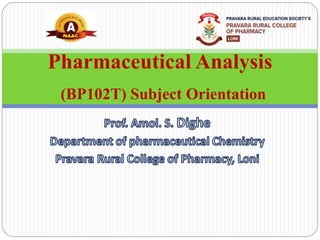
PA-I SUBJECT ORIENTATION.pdf
- 1. Pharmaceutical Analysis (BP102T) Subject Orientation
- 2. Teaching Scheme Evaluation scheme Syllabus Course Objectives Course Outcomes Previous Question Paper Overview
- 3. Teaching & Evaluation Scheme Course Code Course Name Lectures Assigned Theory Practical Tutorial Total BP102T Pharmacy 03 Hrs. per week 04 Hrs. per week 01 Hrs. per week 04 Hrs. per week Course Code Course Name Evaluation Scheme BP102T Pharmacy Theory Practical Total Credit 4 Internal 25 External 75 Total 100 Internal 15 External 35 Total 50
- 4. Evaluation Guidelines End Semester Examination [ 75 Marks]: Paper pattern and marks distribution for End Semester Exam: As per university guideline. Internal Examination [ 25 Marks]: Sessional exam shall be conducted for 30 marks for theory and shall be computed for 15 marks. Similarly Sessional exam for practical shall be conducted for 40 marks and shall be computed for 10 marks. Sr. no Question type Marks 1 Objective Types Questions (Answer 5 out of 7) 5x3=15 2 Long Answers (Answer 2 out of 4) 2x10=20 3 Short Answers (Answer 8 out of 10) 8x5=40 Total = 75M
- 6. Course Outcomes (COs): After successful completion of course student will able to CO1 After successful completion of course student will able to Explain volumetric analysis method for estimation of selected compound officially pharmacopeia. CO2 After successful completion of course student will able to Explain electrochemical analysis method for estimation of selected compound officially pharmacopeia. CO3 After successful completion of course student will able to Explain gravimetric analysis method for estimation of selected compound officially pharmacopeia. CO4 After successful completion of course student will able to Explain various method of expressing conc. & uses of primary and secondary std. for chemical analysis. CO5 After successful completion of course student will able to Explain error in measurement.
- 7. UNIT-I Pharmaceutical analysis- Definition and scope Different techniques of analysis Methods of expressing concentration Primary and secondary standards. Preparation and standardization of various molar and normal solutionsOxalic acid, sodium hydroxide, hydrochloric acid, sodium thiosulphate, sulphuric acid, potassium permanganate and ceric ammonium sulphate Errors :Sources of errors, types of errors, methods of minimizing errors, accuracy, precision and significant figures
- 8. UNIT-II Acid base titration: Theories of acid base indicators, classification of acid base titrations and theory involved in titrations of strong, weak, and very weak acids and bases, neutralization curves. Non aqueous titration: Solvents, acidimetry and alkalimetry titration and estimation of Sodium benzoate and Ephedrine HCl
- 9. UNIT-III Precipitation titrations: Mohr’s method, Volhard’s, Modified Volhard’s, Fajans method, estimation of sodium chloride. Complexometric titration: Classification, metal ion indicators, maskingand demasking reagents, estimation of Magnesium sulphate, and calcium gluconate. Gravimetry: Principle and steps involved in gravimetric analysis. Purity of the precipitate: co-precipitation and post precipitation, Estimation of barium sulphate.
- 10. UNIT-IV Redox titrations (a) Concepts of oxidation and reduction (b) Types of redox titrations (Principles and applications) Cerimetry, Iodimetry, Iodometry, Bromatometry, Dichrometry,Titration with potassium iodate
- 11. UNIT-V Electrochemical methods of analysis Conductometry- Introduction, Conductivity cell, Conductometric titrations, applications. Potentiometry – Electrochemical cell, construction and working of reference (Standard hydrogen, silver chloride electrode and calomel electrode) and indicator electrodes (metal electrodes and glass electrode), methods to determine end pointt of potentiometric titration and applications. Polarography – Principle, Ilkovic equation, construction and working of dropping mercury electrode and rotating platinum electrode, applications Refractometry – Introduction, refractive index, specific and molar refraction, measurement of RI, Abbe’s refractometer and applications
- 12. Previous Question Paper Q1) Answer the following [10 × 2 = 20] a) How will you calculate equivalent weight of acid and base? Explain with example. b) Starch indicator give blue color with iodine, justify it. c) Define the term normality and molality d) Explain accuracy and precision. e) Give the preparation of 0. 1N potassium permanganate with reaction. f) Give applications of polarography. g) Define oxidation and reduction with examples. h) How will you standardize 0.05 M disodium EDTA solution? i) What is half wave potential? j) How will you prepare and standardize 0.1 N Silver nitrate solution?
- 13. Previous Question Paper Q2) Answer of the following (any two) [2 × 10 = 20] a) What is volumetric analysis. Classify them with example. Write principle, reaction of assay for Boric acid and Aspirin. b) Explain methods to determine end point of potentiometric titrations and its application. c) What is complex metric titration? Classify them with example. Write detailed about types of complexometric titrations.
- 14. Previous Question Paper Q3) Answer the following (any seven) : [7 × 5 = 35] a) Explain assay sodium benzoate by non aqueous titration. b) Write a note on accuracy and precision. c) Give an account on solvents used in non aqueous titration. d) Write about limit test of lead. e) Write principle and application of Diazotization titrations. f) Explain construction and working of dropping mercury electrode. g) Write a note on K Fajan’s method? h) Explain principle, reaction of calcium gluconate injection. i) Explain mechanism of co precipitatio
